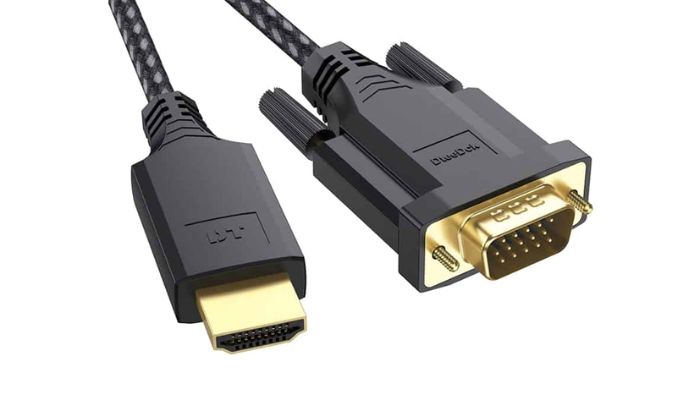Both cables are widely used and the main difference between these two is in the format of the information they transmit. VGA is an analog standard, while HDMI is a digital standard. They also come with the advantages and disadvantages of each pattern. VGA is an older standard that only carries a video signal. HDMI is the most common cable standard for newer electronic devices like Blu-Ray players or LED TVs. HDMI can carry digital audio and video signals while encrypting data with HDCP (High-bandwidth Digital Content Protection High-bandwidth Digital Content Protection is a solution designed to prevent illegal copying of high-definition media) . The video quality obtained with a VGA cable is noticeably worse when compared to that of HDMI. Even so, HDMI may soon be phased out, as USB 3.1’s versatile Type-C connector has the potential to replace the HDMI standard.
Capability: HDMI vs. VGA
VGA cables are designed to carry only video signals from a device to a monitor. At the time they were first released (1987), analog signals were the norm. When digital signals became more common, VGA cables were enhanced with converters to allow analog to digital conversion. However, newer display devices also used digital signals, so the process became a two-step conversion from digital to analog and back to digital, with simultaneous signal degradation. The analog signal would lose some information on conversion to digital, and more information is lost when converted back to digital. Also, analogue signals carry less information than digital ones, so the original image of this scene starts off as less “sharp” than what can be obtained in digital.
On the other hand, the HDMI standard allows the transfer of digital video and audio signals through the same interface (port) and cable, capable of providing high definition (HD) video in resolutions of 1920 x 1200 pixels and 8 channels of audio simultaneously. By supporting digital copy protection of all signals, HDMI cables are included for devices such as Apple TV, Blu-Rays and game consoles, among other similar electronic products.
Signal Quality
VGA cables are subject to crosstalk (signal interference from other cables) and length issues; beyond about one and a half meters, the analog video signal tends to lose quality. HDMI cables are less sensitive to crosstalk (signal interference), but can be affected by electromagnetic fields. To avoid this problem in tight spaces with multiple cables, the best HDMI cables offer thick insulation. However, most standard HDMI cables offer excellent connections and solid performance without the need for expensive cables.
Entry Delay
Another difference between HDMI and VGA cables is regarding input delay, which can directly affect your quality of use on the display devices you intend to use. Input lag can refer to one of two things: the delay between a display device, such as a TV or monitor, receiving a signal and displaying it, or the delay between pressing a button on a video game and seeing the game run corresponding action. VGA connections generally exhibit less input lag than HDMI connections because they do not apply post-processing to the input. Post processing is similar to a Photoshop filter in that it applies effects such as depth of field, motion blur, and color correction. Although disabling post-processing slightly reduces image quality, it decreases input lag. There is an option on some TVs called “Game Mode” that also disables post processing. Another factor in input delay is the use of adapters. Technically, each additional device introduces some delay due to the extra distance the electrons have to travel, but this is negligible. Using low-quality, unofficial adapters can also significantly increase input lag.
Compatibility
Another point to take into account is the compatibility between the inputs of the devices you want to use and the cable standard you prefer. VGA cables are incompatible with HDMI ports, except when using converters. Even with converters, video signal quality is greatly compromised when using VGA cables, so they often serve as a stopgap measure. Audio requires a separate cable. If HDMI cables are used with a VGA port, a converter unit and a separate cable are required to connect the video display and deliver the audio signal to a separate port.
Applications
Although the VGA connection seems to lose out in all respects to newer standards, the main advantage of a VGA connection today is that older technologies such as projectors are almost always compatible with them. Most PC gamers, however, prefer using HDMI connections for their faster response times (the speed at which the on-screen image refreshes or changes; the longer the response times, the more motion blur is visible ), presence in most modern monitors, low cost of cables, as well as its ability to carry both audio and video. However, HDMI 1.4 is limited to 4K resolution at 30 FPS, and while HDMI 2.0 supports 4K at up to 60 FPS, the newer version isn’t very common; also, as stated earlier, without “game mode”, HDMI connections tend to have higher input lag. Another application of HDMI connections is on Macs. Although only post-2010 Mac Mini models, post-2012 MacBook Pro models, and late 2013 Mac Pro models come with HDMI ports for connecting to HDTVs and other displays, other models can still use a mini DisplayPort to HDMI adapter to connect via HDMI port.
Price Range
VGA cables, as they have fallen out of favor, are generally inexpensive and readily available online. Converters can cost substantially more than cables because they are more specialized. HDMI cables are more expensive than previous standard VGA cables. This is reflecting the fact that HDMI offers higher quality, single-cable audio-visual returns. Prices for HDMI cables vary greatly depending on their manufacturer, quality and length. You can find good places to buy cables in our article on shopping apps. Thus, you can buy the cables discussed in this article with all the comfort that your cell phone can provide you.
